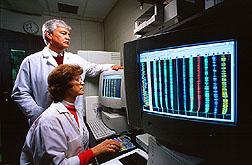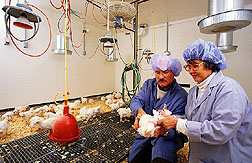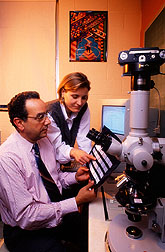Old Virus Morphs Into New Chicken Threat
In the past 2 years, a new strain of avian leukosis virus has swept like wildfire through the broiler breeder chicken industry around the world. It has attacked the industry at its source, decimating the breeder birds that are the parents of the birds we eat.
Gregorio Rosales, president of the U.S. Primary Breeders Veterinary Roundtable, says losses of breeder birds can be as high as 20 to 40 percent in the most severe cases. The usual loss is 1 to 2 percent per week during the phase when birds are at their peak of laying the eggs that will be raised as broilers.
The roundtable includes the top seven U.S. primary breeders--that account for 95 percent of the U.S. broiler industry. Rosales, a veterinary medical officer with Ross Breeders, Inc., of Elkmont, Alabama, says infections are now occurring in younger chickens and spreading faster than any other avian leukosis virus (ALV) known before. This new strain, referred to as ALV subgroup J, was first isolated in England in 1989 and in the United States in 1994. Infections caused by this virus reached epidemic proportions in 1996.
Shortages of breeding stock are already showing up, according to Rosales. He says this threatens the industry's ability to meet the burgeoning demand for chicken on the dinner table. U.S. industry managers, for example, are concerned that they may not be able to keep up with consumer demand for almost 8 billion broilers a year. "The threat to breeding companies is enormous,"says Rosales.
"If a producer goes out of business, a gene pool assembled over many years of breeding is lost. And this would be a serious loss, since there are no more than eight major breeding firms in the world,"he says.
Murray R. Bakst, acting head of the Agricultural Research Service' Avian Disease and Oncology Laboratory located near the campus of Michigan State University at East Lansing, says the industry came to that lab for help.
This makes sense, says veterinary medical officer Richard L. Witter, because the East Lansing lab was set up in 1939 for a similar crisis--involving less virulent strains of avian leukosis. In the same spirit of cooperation seen today, Michigan State then donated 50 acres of land for the lab.
Witter formerly headed the East Lansing lab but has recently returned to full-time research, spending some of his time working with avian leukosis.
Witter, who has followed the disease for much of his career, says that the virus that causes the often-fatal tumors in chickens was first isolated in the 1940s by Ben R. Burmester at the East Lansing lab. Subsequent research found that avian leukosis is actually caused by a group of viruses. Before 1989, five sub-groups affecting chickens had been identified, A through E.
"Until sub-group J,"says Witter, "the various strains of the virus predominantly caused lymphoid tumors that grow from cells in the chicken's bursa, an organ near the end of its intestinal tract. The new strain causes predominantly myeloid tumors, which grow throughout the body, often on bone surfaces."
Witter says the breakthrough that led to solving the earlier avian leukosis problem came in 1977 with ARS' development--in concert with industry--of a quick test. Over the next 10 years, a detect-and-eradicate strategy was put into action, and the industry was on a secure path.
Until now.
New Measures Needed
Once found only in egg-laying breeds, the disease has quietly evolved into a new strain found only in chickens raised for meat.
The ALV-J strain renders the industry's detect-and-eradicate strategy useless. It is also highly variable, seeming to change constantly, and it spreads too fast. By the time it is detected and the infected birds are removed, it has already spread to other chickens.
"That's terrible for eradication,"says Aly M. Fadly, the ARS veterinary medical officer who heads the ALV-J research team.
Unfortunately, Fadly says, team members may have to unlearn what they know about avian leukosis, because the new strain is so different. "It may require an entirely new control technology,"he says.
The J subgroup was first isolated in 1989 by L.N. Payne (retired), formerly with ARS' British counterpart agency, the Institute for Animal Health, located in Compton Newbury, Berkshire, England.
Fadly identified the U.S. strain in 1994. Telephone calls from industry convinced him by 1996 that the J strain was spreading far more rapidly than other strains. He says a typical call went like this: "Although we removed all the hens infected with ALV-J, we're still finding new ALV-J cases in their penmates."
Earlier ALV strains were poor at spreading by contact. Just removing infected chickens solved the problem. But the J strain spreads with deadly efficiency from hen to hen and chick to chick.
"We don't yet understand how it moves so fast,"Fadly says.
"Myeloid leukosis is probably the biggest threat to the broiler industry worldwide at the moment,"says Rosales.
"There is a tremendous need for universities and federal programs to continue working on it. The ARS lab at East Lansing and Britain's Institute for Animal Health have been leaders in poultry tumor research,"he says, "particularly East Lansing. If it weren't for their work, we wouldn't have the industry we have today."
Fadly, who serves as adviser to the Primary Breeders Veterinary Roundtable, says the J research team at East Lansing is working with world-class scientists. These include Kathleen Conklin at the University of Minnesota at St. Paul, an expert on the molecular biology of tumor-causing viruses, and Hsing-Jien Kung, a tumor expert at Case Western University in Cleveland, Ohio.
Both Conklin and Kung are interested in learning how retroviruses such as the J virus cause cancer. Conklin is also intrigued by the variability of the J virus and its ancient wildfowl genes.
Payne had found a switch point, where two chains of genes from two different strains of avian leukosis--subgroup A from modern-day wildfowl and an ancient subgroup found in every chicken's genome, or genetic library--recombined.
The J virus cannot infect people or other animals besides chickens. Retroviruses like J reverse the normal viral replication process of injecting viral DNA into an infected cell to reproduce viral RNA. When a retrovirus infects a cell, it injects its RNA into the cell, along with an enzyme that uses the RNA template to make a DNA viral molecule. The retrovirus becomes part of the infected animal's genetic makeup.
Hubbard Farms, Inc., of Walpole, New Hampshire, is one of the primary breeding companies represented in the roundtable firms. In a cooperative research and development agreement with this company, ARS developed a DNA-based test for detection of the virus, called a polymerase chain reaction (PCR) test. ARS expects to sign many more such agreements with companies, including a diagnostic lab, for work on a quick detection test that can be used in the field.
In 1997, the East Lansing lab pulled out all the stops. By June, the lab's leader received permission to redirect $200,000 to J research. Six of the unit's eight scientists spend at least some of their time on this work. Fadly has a growing number of technical assistants, including two technicians and two Michigan State University graduate students. He is also working with poultry experts in the public and private sectors and is collaborating with scientists at the University of Georgia at Athens and the University of Delaware at Newark.
Recently, Fadly received 10 samples of J viruses found on breeder farms. Team member Robert F. Silva, a microbiologist, used the PCR test to see how variable these samples were. His tests gave the first proof that they were as variable as feared.
"They have changed greatly since they were first detected in England in 1989,"says Silva, "and everyone is wondering what changes are yet to come."
Solid evidence emerged once Silva went on to map genes of key parts of the virus samples. In comparing the new samples with each other and with the strain found in England, he confirmed significant genetic changes, including the loss of stretches of DNA in one sample.
"Because of this extreme variability, it will be difficult to develop effective vaccines and diagnostic tools,"Silva says.
The discovery of sub-group J caught the ARS unit, as well as the industry and researchers everywhere, off guard. For one thing, the chicken pens at East Lansing had been built for smaller White Leghorn egglayers, next to which broilers look like turkeys. The lab's pens and cages were too small for the broilers.
The veterinary roundtable gave the East Lansing lab $140,000 for poultry research. This freed up more ARS funds, in addition to the $200,000 in redirected funds, to buy new cages and retrofit the lab and chicken pens for broiler research. The lab's maintenance staff worked overtime and had the pens ready by the end of 1997. The first broilers arrived in January 1998.
ARS immunologist Henry D. Hunt is exploring the idea of a quick test that could spot the virus and lead to removal on the same day a chick hatches. He is taking blood samples from broiler chicks to look for virus-infected cells. He also wants to see if he can use chicken cells to produce ALV-J proteins for a possible vaccine.
Meanwhile, ARS biochemist Lucy F. Lee is working on developing a genetically engineered vaccine.
"We're building an ever-expanding consortium of private industry, university, and federal researchers to solve the problem,"says Witter. --By Don Comis, Agricultural Research Service Information Staff.
Murray R. Bakst is at the USDA-ARS Germplasm and Gamete Physiology Laboratory, Bldg. 262, 10300 Baltimore Ave., Beltsville, MD 20705-2350; phone (301) 504-8795, fax (301) 504-8546.
Richard L. Witter, Aly M. Fadly, Robert F. Silva, Henry D. Hunt, and Lucy F. Lee are at the USDA-ARS Avian Disease and Oncology Laboratory, 3606 East Mt. Hope Rd., East Lansing, MI 48823; phone (517) 337-6828, fax (517) 337-6776.
"Old Virus Morphs Into New Chicken Threat" was published in the August 1998 issue of Agricultural Research magazine. Click here to see this issue's table of contents.









